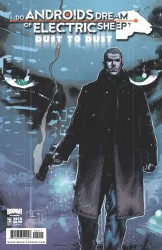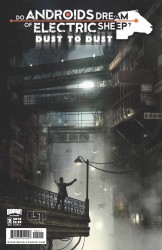![]()
I love Philip K. Dick. That’s L-O-V-E in huge letters – he’s one of my favourite authors of all time. So it has been with a great sense of curiosity that I’ve been reading this authorised prequel to Dick’s novel Do Androids Dream of Electric Sheep? Find out my thoughts after the jump…

 Do Androids Dream of Electric Sheep? Dust to Dust #2
Do Androids Dream of Electric Sheep? Dust to Dust #2
Writer: Chris Roberson
Art: Robert Adler
Colours: Andres Lozano and Javier Suppa
Letters: Jimmy Betancourt
Editor: Bryce Carlson
Covers: Trevor Hairsine with colours by Andres Lozano (Cover A), Benjamin Carré (Cover B)
Publisher: BOOM! Studios
Previously on Do Androids Dream of Electric Sheep? Dust to Dust: Malcolm Reed is a ‘special’ – a man mutated by the radioactive dust that is now ubiquitous on Earth after a nuclear war, whose mutation allows him to sense the emotions of others; however, Reed is also a schizophrenic and thus has no emotions of his own. He is recruited by Federal Agent Charlie Victor, to aid him in seeking out a group of rogue androids – but Charlie is an android himself. Meanwhile, the leader of the rogue androids – Talus – is informed of Victor’s hunt and begins to make plans. Finally, Dr. Samantha Wu is conducting research into the effects of the radioactive dust on animal life.
I Really Like Dick
In this issue we see Charlie and Malcolm tracking the rogue androids to where one of them recently worked – the office that controls all surveillance equipment for the entire city, and their facial-recognition system is broken. In her lab, Dr. Wu feels an unanticipated amount of empathy for her lab-rabbit, and starts to think about a new religion called Mercerism. Talus and the other androids plot, suggesting that they aim to destroy all remaining human life. The book ends with one of the rogue androids, who looks exactly like Victor, impersonating him at the police station.
It is best, I think, to start by talking about how I approached this book. I realised that it would, of course, be wrong of me to expect Roberson to attempt to emulate the writing of Philip Dick. For one, judging a writer by the standards of my favourite author is quite unfair and secondly, comic books are a distinctly different medium to novels. What I did expect, however, was for a prequel to Do Androids Dream of Electric Sheep? to attempt to capture that distinctly Dickian feel, the atmosphere that is present in all his works.
So, did this book meet my expectations? The answer, of course, requires some discussion. Different sections met with varying successes: the Charlie and Malcolm parts definitely gave off a Dickian vibe, and there is a brilliant moment in the first few pages that really got me believing that this book is a prequel to one of Dick’s works. The Samantha Wu section shows promise: rather than being about her research into the affects of the dust (I was rather dismayed at the possibilities for that type of story when reading the first issue), this plot thread now seems to be moving towards Samantha’s exploration of empathy and Mercerism, something that I’m interested in seeing. The Talus section was the least satisfying, and I really hope that Roberson is going to defy my expectations (how Dickian that would be!) rather than go for a straight ‘androids attempt to destroy the world!’ plot – and, considering how good other parts of the book are, I’m willing to give him the benefit of the doubt on this one.
The book is very well written in its own right as well. It’s all very tight: there’s no padding here at all – every panel has a purpose. One of my favourite things about Dick’s writing is his characters – his ability to write people that I can form a connection with – and I get the same sort of feeling from this book. The characters are all very genuine, and even in this second issue I find myself caring about them. Something I don’t mind being different from Dick’s works is the updated technology: Wu uses a twitter-a-like, people have mobile phones and there are computers that don’t weigh tonnes. Herein Roberson demonstrates that it is entirely possible to make changes to a setting without harming the work.
Pictures to Match the Words
The art has its own style, and it reminded me somewhat of the work of John Romita Jr. – which I regard as a good thing. The character of Malcolm Reed appears to be drawn similar to Keanu Reeves in his roll as Bob Arctor in the film adaptation of the Dick novel A Scanner Darkly; I don’t know if this is an intentional reference or not, but it’s certainly a clever way to draw him as, I think, Reed is a classic Dick-style character. However, Victor seems to be drawn a whole lot like Rick Deckard in the Do Androids Dream of Electric Sheep? main book, and this annoys me as the connection clearly implies that Deckard is an android himself, which he most definitely is not (and in that I fear Blade Runner’s malevolent influence, but I digress). Despite any perceived references, though, I thought the art was great throughout and especially enjoyed both the character design and the look of the buildings, which just felt right. The book is also very well coloured; with the palette appearing richer in the Charlie/Malcolm sections – demonstrating the intenseness with which Malcolm senses emotions – with a more subtle colour scheme for the cold scientist of Dr. Wu and an engaging use of light and dark in the dark apartments of the rogue androids.
Both covers are well-drawn, with Cover A depicting a man who I assume is meant to be Charlie Victor holding a smoking gun with a face (who is possibly meant to be Talus?) in the background, and Cover B showing a man (who could be anyone but who I think is meant to be Reed) looking out on a very Blade Runner esque city. However, neither cover has much to do with what is going on in the book, and the man on Cover A does not look a whole lot like the Victor inside the issue. I have been surprised (but pleasantly so) that the city in this series does not look like that of Blade Runner at all, and so Cover B doesn’t particularly please me either (although the visual style is the least of my problems with Blade Runner, but that’s not for this review).
How Very Dickian of this Book to Defy my Expectations
I was very much prepared to hate this book, to go on a huge fan-rant against it and drop it in disgust. But that is the very opposite of my experience: not only does it stand up on its own merits but it manages, at times, to capture that distinctly Dickian style and honestly makes me believe that this is a prequel to Do Androids Dream of Electric Sheep? Add on to that great art and I have no qualms about giving this book five stars out of five. Buy it if you like Philip K. Dick, buy it if you like good science fiction, or buy it if you just like great comic books.




2 Comments
oh crap, now i’m gonna have to pick this one up too.
Do I need to know any backstory here, or should I read the book before any of this will make any sense? My only experience with this material was Blade Runner and I couldn’t understand what was going on in that movie. People had said that it was good, but I just didn’t know what was going on and I didn’t know that it was from a book. I kinda liked A Scanner Darkly though, so I got that going for me (no help here though).